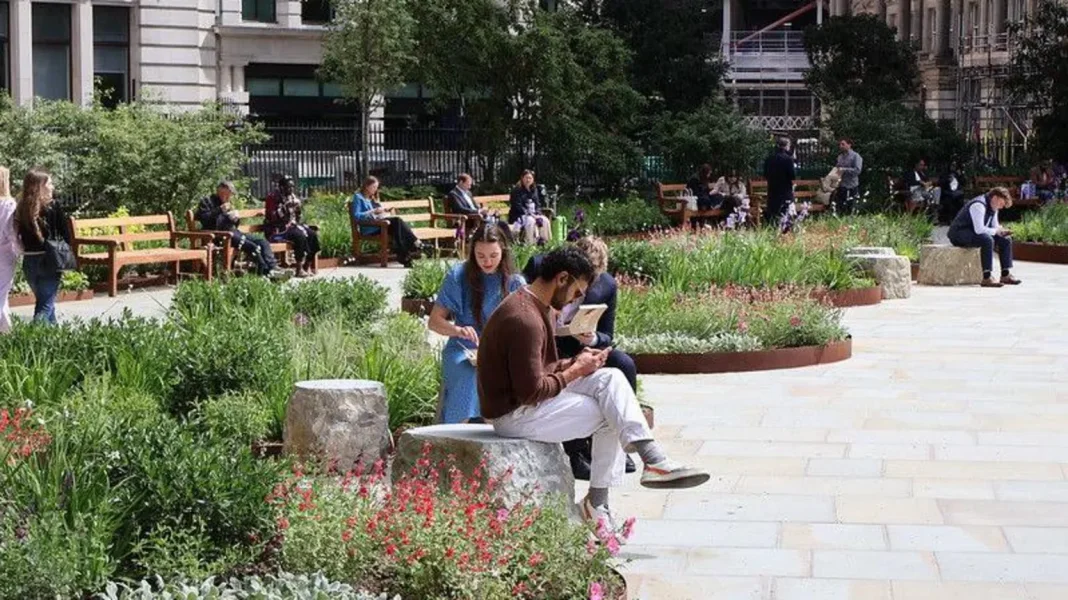Design by Realm for City of London. Photo credit: Realm. @realmlandscape
Finsbury Circus Gardens marks triumphant return as Square Mile’s premier oasis after extensive Elizabeth line construction.
After spending the better part of a decade buried beneath construction equipment and safety barriers, London’s oldest public park has made a spectacular comeback, emerging from its Crossrail-induced hibernation with significant environmental enhancements and restored Victorian-era charm.
Finsbury Circus Gardens, which holds the distinction of being the capital’s inaugural public green space, has undergone a comprehensive regeneration program that goes far beyond simple restoration. The Grade II listed site now boasts dramatically improved biodiversity, featuring an additional dozen tree species, over 13,000 newly planted specimens, and 6,000 bulbs strategically positioned throughout the landscape.
From Moorland to Metropolitan Oasis
The site’s remarkable journey began in the 1600s when it first welcomed public visitors as “Moor Fields,” transforming what was once marshy terrain into London’s pioneering experiment in accessible green space. The formal design elements visitors recognize today were implemented by renowned architect George Dance the Younger in 1815, establishing the geometric layout that has defined the space for more than two centuries.
This historical significance makes the recent restoration particularly poignant, as the park represents not just a recovered green space but a restored piece of London’s urban development heritage.
Construction Sacrifice Yields Long-term Gains
The extensive closure, which began when Crossrail operations required the gardens as a construction staging area for the Liverpool Street Elizabeth line station, initially appeared to be a devastating blow to the Square Mile’s limited green infrastructure. However, the City of London Corporation seized this disruption as an opportunity for comprehensive improvement rather than simple maintenance.
The transformation project, launched in 2023, has delivered improvements that extend well beyond the park’s pre-construction state. Enhanced seating arrangements, revitalized lawns, and sophisticated landscaping create an environment that balances historical authenticity with contemporary environmental stewardship.
Biodiversity at the Heart of Urban Planning
The restoration prioritizes ecological enhancement, reflecting modern understanding of urban green spaces as crucial environmental assets rather than merely aesthetic amenities. The introduction of 12 additional tree species represents a deliberate strategy to increase habitat diversity and strengthen the park’s resilience against climate challenges and urban stressors.
Chris Hayward from the City of London Corporation emphasized the park’s renewed role as a “tranquil” space that has been “revitalised and ready to be rediscovered,” highlighting how the restoration balances peaceful recreation with environmental responsibility.
Square Mile’s Green Infrastructure Success
The reopening reinforces the outsized impact of the City of London’s compact green spaces, which collectively attract over 21 million annual visits despite the area’s limited geographic footprint. James St John Davis, chairperson of the corporation’s natural environment board, noted that these spaces “truly punch above their weight” in providing essential respite from urban intensity.
The gardens’ role as the largest open green space in the Square Mile makes this restoration particularly significant for workers, residents, and visitors seeking natural environments within one of the world’s most densely developed financial districts.
Phased Return to Public Access
The park’s return follows a carefully planned timeline, with partial reopening occurring on May 6 and the official ceremony scheduled for June 4. This staged approach allows for final adjustments while providing immediate access to a community that has waited nearly a decade for this green space to return.
The timing coincides with increased recognition of urban green spaces’ importance for mental health, environmental sustainability, and community well-being—factors that have gained prominence since the original closure began.
Legacy of Adaptive Urban Management
Finsbury Circus Gardens’ transformation demonstrates how major infrastructure projects can serve as catalysts for environmental improvement rather than merely sources of temporary disruption. The Corporation’s approach of using construction necessities as opportunities for enhancement offers a model for other urban areas facing similar challenges.
Hayward concluded that these enhanced green spaces are essential for “making the Square Mile a welcoming and attractive place to live, work, and visit – delivering on our vision for a more inclusive, innovative, and sustainable City.”
The successful restoration of London’s first public park represents more than recovered green space—it exemplifies how historical preservation, environmental stewardship, and modern urban needs can align to create spaces that honor the past while serving contemporary communities more effectively than ever before.
A Little Bit of London In Your Inbox Weekly. Sign-up for our free weekly London newsletter. Sent every Friday with the latest news from London!




